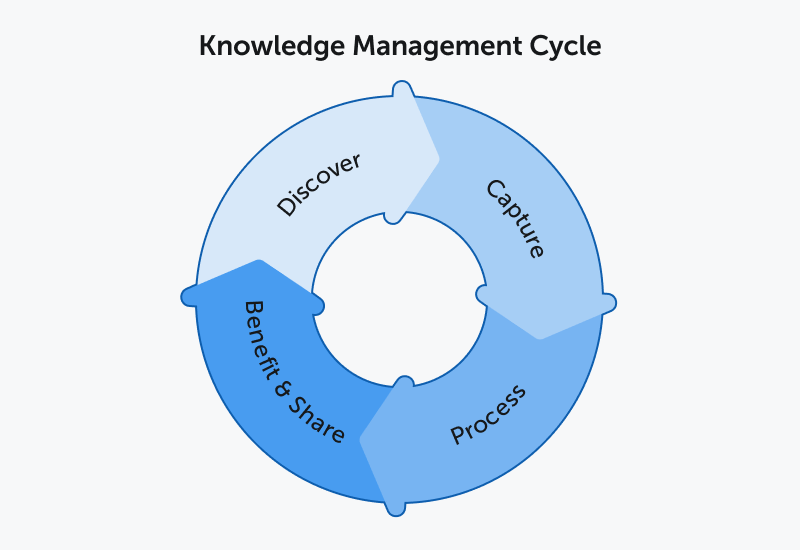Knowledge management
Learn what knowledge management is. Why it’s important, and what are the benefits? Discover examples and methods that can be used in the knowledge management process.

Taking advantage of all the expertise within an organization is a great way to maximize its potential. Companies have a well of untapped knowledge within their workforce that is lying dormant or siloed to individual staff or departments.
With the proper management structures in place, this knowledge can be found, stored, and made accessible to the wider workforce, offering tangible business benefits.
Discover:
- What is knowledge management?
- Knowledge management in practice
- Types of knowledge
- Examples of knowledge management
- Importance of knowledge management
- Benefits of knowledge management
- Knowledge management process
- Knowledge management methods
- What are knowledge management systems?
What is knowledge management?
Knowledge management is the conscious process of defining, structuring, retaining, and sharing the knowledge and experience of employees within an organization.
As organizations evolve, expand into new areas, and define their approach to business, they develop significant institutional knowledge. This information is invaluable to the company. Imparting it to new or less experienced staff is vital for maintaining successful operations.
The primary goal of knowledge management is facilitating the connection of staff looking for information, or institutional knowledge, with the people who have it.
With practical knowledge management in place, organizations can spread information and raise the level of expertise held by specific individuals or teams to improve the efficiency of their practices.
It often refers to training and learning in an organization or of its customers. It consists of a cycle of creating, sharing, structuring, and auditing knowledge to maximize the effectiveness of an organization’s collective expertise.
Knowledge management in practice
Knowledge management can be separated into three main areas:
- Accumulating knowledge
- Storing knowledge
- Sharing knowledge
By accumulating and storing the staff’s knowledge, companies hold onto what has made them successful in the past. In addition, sharing this information throughout the organization informs staff of past approaches that improve performance or better inform new strategies.
To achieve the goal of knowledge management, companies have to enable and promote a culture of learning and development, creating an environment where employees are encouraged to share information to better the collective workforce.

How to conduct a skills gap analysis and what to do next
Start building your foundation for strategic workforce development.
Download guideTypes of knowledge
When discussing knowledge management, it is helpful to consider the different types of knowledge and how it is possible to share them within an organization.
The information knowledge management covers can generally be broken down into three main types:
1. Explicit knowledge is knowledge and information that can be easily codified and taught, such as how to change the toner in a printer and mathematical equations.
2. Implicit knowledge is knowledge that explains how best to implement explicit knowledge. For example, consider discussing a task with an experienced co-worker. They may provide explicit steps detailing how to complete the job. But they may also use their understanding of the situation to consider different options and decide the best approach for your given circumstances. The experienced employee utilizes and shares their implicit knowledge to improve how the team operates.
3. Tacit knowledge is knowledge gained through experience. Therefore, it is more intuitive and less easy to share with others. Examples of tacit knowledge are “know-hows”, innovative thinking, and understanding body language.
While knowledge management for implicit and tacit knowledge can be harder to implement, with correct procedures in place, you can ensure all relevant information is shared around the company and retained as staff retire or move on.
Utilizing all the expertise in your company benefits the business as a whole, creating best practices for everyday tasks, improving situational awareness, developing employee intuition for course corrections, and enhancing organizational capacity.
Examples of knowledge management
Staff retiring
An employee’s knowledge and skillset grow as they spend time with an organization. As a result, staff typically retire with a wealth of expertise that the company needs to mine using efficient knowledge management processes in order to reduce disruption and prevent workforce knowledge gaps.
This means identifying and capturing the meaningful information that needs to be retained by the organization and determining the best approach for storing and distribution.
Employee transfer or promotion
When staff change positions within a company, they must develop additional skillsets and expertise to match their new role.
Efficient knowledge management procedures simplify delivering this information to create a seamless transition from one position to another.
Why is knowledge management important?
Knowledge management is important because it boosts the efficiency of an organization’s decision-making ability.
By making sure that all employees have access to the overall expertise held within the organization, a smarter workforce is built that is more able to make quick, informed decisions, benefiting the entire company.
Knowledge management allows innovation to grow within the organization, customers benefit from increased access to best practices, and employee turnover is reduced.
The importance of knowledge management is growing every year. As the marketplace becomes ever more competitive, one of the best ways to stay ahead of the curve is to build your organization in an intelligent, flexible manner. You must have the ability to spot issues from a distance and be able to respond quickly to new information and innovations.
Companies begin the knowledge management process for many different reasons.
- A merger or acquisition could spur the need for codifying knowledge and encouraging teams to share their expertise.
- The imminent retirement of key employees could demonstrate the need to capture their knowledge.
- An upcoming recruitment drive shows the wisdom in using knowledge management to assist in training new employees.
52% of respondents in Deloitte’s 2021 Global Human Capital Trends Survey stated workforce movement as the driving force behind proactively developing knowledge management strategies.
Whatever the reason is, implementing knowledge management processes offers tangible benefits that drive value. This is backed up by research, showing knowledge management positively influences dynamic capabilities and organizational performance.

How to conduct a skills gap analysis and what to do next
Start building your foundation for strategic workforce development.
Download guideBenefits of knowledge management
A survey of over 286 people working in knowledge management across a range of industries, locations, and company sizes found the most significant benefits to be:
- Reduced time to find information
- Reduced time for new staff to become competent
- Reduced operational costs
- Improved customer satisfaction
- Improved bid win/loss ratio
Making knowledge management a significant part of a company’s leadership approach produces a more streamlined workforce with faster onboarding and well-informed staff that provide a better experience for customers.
Knowledge management is a critical tool for any company that wants to increase its bottom line and market share.
IDC estimates that Fortune 500 companies lose $31 billion from not sharing knowledge within their organization every year. Studies estimate improving employee access to information and tools could save organizations roughly $2 million a month for every 4000 employees.
Knowledge management process
Implementing effective knowledge management requires proactive strategies and incorporating multiple new processes.
Companies have to uncover the existing knowledge available to them, understand how to spread this information to produce additional value, and plan what this looks like in action.

Knowledge management process. Credit: Valamis. (CC BY 4.0)
1. Discovery
Every organization has multiple sources of knowledge, from employees to data and records.
This could be the education and skillsets staff bring to the job, the experience and unique expertise they develop on the job, or hard drives of data that can positively affect the business with proper analysis.
During the discovery process, organizations must identify all the available sources of knowledge, with a particular emphasis on information that could be easily lost.
This process is simplified by a strong understanding of where and how knowledge flows around the organization.
2. Collection
Collecting all the available knowledge and data creates the foundation from which future processes build.
Sloppy or incorrect knowledge collection leads to decisions without a complete understanding of the organization and its capabilities.
Companies must audit their existing staff expertise, documentation, and external knowledge sources. A range of tools is available to help, including automated surveys, document scanning, and metadata.
Post-implementation, many organizations redefine internal processes to make capturing institutional knowledge a part of everyday processes. This could be through continual employee feedback systems or more in-depth offboarding procedures.
3. Assessment
This process involves the deep analysis of the knowledge gathered in the previous two steps. Data must be assessed and organized into a structured, searchable, and easily accessible form.
Assessment of the gathered knowledge is required to ensure it is accurate, offers value, and is up to date.
Then teams can determine how best to share information to improve company performance and give staff the knowledge they need to maximize performance.
Utilizing the right knowledge management system simplifies this process by allowing leadership to organize, assess, segment, and store a comprehensive knowledge database.
4. Sharing
The whole point of knowledge management is to give staff the expertise and information they need to do their job to the best of their ability.
Once you have built a detailed and accurate body of knowledge related to your company, you need to plan how it will be shared.
See the “Knowledge management methods” section below for examples of how to share information around your company.
While there are many examples of sharing information, one thing that should be universal is creating a cultural shift towards learning and development.
Leadership must prioritize and reward knowledge sharing, creating an atmosphere where team members are actively encouraged to both teach each other and learn from one another.
5. Application
This is the step where organizations reap the rewards of knowledge management. Discovering and storing institutional knowledge is just the beginning.
Staff utilizing newly acquired expertise in their tasks brings a range of benefits in productivity, accuracy, decision-making, and more innovative employees.
6. Creation
The final stage of knowledge management is to create more knowledge.
It should never be considered a one-and-done process. A single audit and rollout won’t deliver the results you are looking for.
Knowledge management is a continual process that maximizes a company’s performance for the expertise available to it.
Whether it is a team discovering a new, more efficient approach to a task or a better way of capturing data related to company performance, organizations should constantly be innovating and creating new knowledge to pass on to future employees.
Knowledge management methods
Depending on what the company needs, their knowledge management will look different.
Below we have listed common examples of knowledge management methods in action:
1. Tutoring & training, communities of practice, and Q&A
These examples all involve transferring information directly from the knowledge holder to other employees.
This could be through in-person tutoring, company-wide training sessions, online chats, and group discussions – or a mix of these options and others.
Many companies value building a skills matrix that maps each employee’s expertise. This simplifies finding the employee with the most experience or knowledge in a given field. In addition, it identifies knowledge gaps within the workforce and shows areas requiring focus for specific knowledge management methods and training.
Some examples of this type of knowledge management may not require a formalized structure. For example, perhaps your company is having problems with a new project, which reminds you of a previous situation. Using the company Slack, for example, you can search for similar questions and find old threads discussing how you overcame the problem last time. Prior expertise that you may not have thought about in years is stored and discovered in old communications to help you right now.
Pros:
- Questions can be immediately answered
- Clarifications can be made if the material is not understood
- Brainstorming sessions can be facilitated, taking advantage of the combined power of the group’s experience and knowledge
- In-person learning tends to be remembered more clearly
Cons:
- It can be time-consuming and take away from the tasks the knowledge holder is trying to complete
- A system of expertise location can be time-consuming to build and maintain
- It can be challenging to document and save for future use
- Difficulty finding the right expert with good communication skills and knowledge of the company
- You can lose the knowledge if the knowledge holder leaves the company
2. Documentations, guides, guidelines, FAQ, and tutorials
Written communications are great for storing and transferring knowledge.
With text-based knowledge management, a system to store, categorize and navigate subjects is always available.
In many cases, metadata is a great help for this.
Pros:
- The company has an invaluable source of information of up to date information
- Easy to find and share online (when organized well)
- Can easily combine multiple people’s expertise into one packet
Cons:
- Requires a lot of time to create and keep up-to-date
- Must be appropriately managed to ensure relevant knowledge is easily found
- Requires infrastructure (internet access, etc.)
- It takes time to consume
3. Forums, intranets, and collaboration environments
These online resources spark conversation and bring many knowledge holders into the same place.
Threads, subforums, and groups can be divided by topic, level of expertise, or any number of other classifications.
Pros:
- Collaboration drives innovation
- Many experts can be brought together into one place, no matter their location globally
- Facilitating contact with remote teams helps teamwork and knowledge transfer
Cons:
- It can be a chaotic, noisy environment
- Knowledge is not actively being vetted as it is added to discussions
- Searching through many messages and threads for relevant answers is time-consuming
- Messages and threads might not be archived
4. Learning and development environments
Creating an environment where learning is considered an asset will continuously drive employees to educate themselves.
Incentivizing them to take advantage of your knowledge management systems will result in upskilled employees ready to take on leadership roles in your organization.
For this to happen, there must be structured and accessible learning and development technology in place that employees can use.
Pros:
- Motivated employees can develop themselves at will
- Training pathways can be set out
- Wide range of resources available to produce a constant flow of fresh content
- The structure allows for easier discovery of subjects
- Authoring tools available such that internal experts can build company-specific courses
- Analytic tools are available to help find knowledge gaps inside the company
Cons:
- Requires a lot of effort to develop and maintain in house
- Readily available solutions may be too generic to add real value for your company
- Content must be created and continually updated
- Requires an influential learning culture to motivate staff to participate
5. Case studies
These in-depth studies into particular areas serve as complete guides to a subject.
Looking at the actions taken, the results they produce, and any lessons learned is extremely valuable.
Pros:
- Allow for complete documentation and archiving of lessons learned
- Easily shareable
- Efficient for communicating complex information
Cons:
- It takes a lot of time and skill to create
- The case study may have limitations or require approval from the parties involved
- Can be too specialized to apply the knowledge broadly
- In fast-paced fields that are constantly innovating, case studies can become out of date quickly
6. Webinars
These online seminars can be beneficial in widely disseminating ideas throughout teams, branches, or the entire company.
Pros:
- Accessible for all interested employees to attend
- Potential for interactivity where attendees can ask questions specific to issues they are having
- Can be recorded and reused
Cons:
- Planning, finding the right speakers, and settling on a topic is time-consuming
- Requires organization
- External experts can cost a lot
- Requires time to find answer
What are knowledge management systems?
Knowledge management systems are IT solutions that allow for the storage and retrieval of the information stored within the company, allowing for better collaboration and more efficient problem-solving.
Depending on what your company needs, they will have different features.
Examples of knowledge management systems are:
- Feedback database – Everyone involved in a product, from designers to salespeople to customers, can share their feedback with the organization. All stakeholders can access the feedback and thus quickly make fundamental changes armed with better information.
- Research files – In developing projects and ideas, a company does market and consumer research to determine what is needed, what niches are yet to be filled in the market, and what trends can be forecasted. The files are then shared within the organization to allow all departments to benefit from the research conducted.
Shared project files – This system allows for greater collaboration and teamwork, especially across distances.

How to conduct a skills gap analysis and what to do next
Start building your foundation for strategic workforce development.
Download guide



